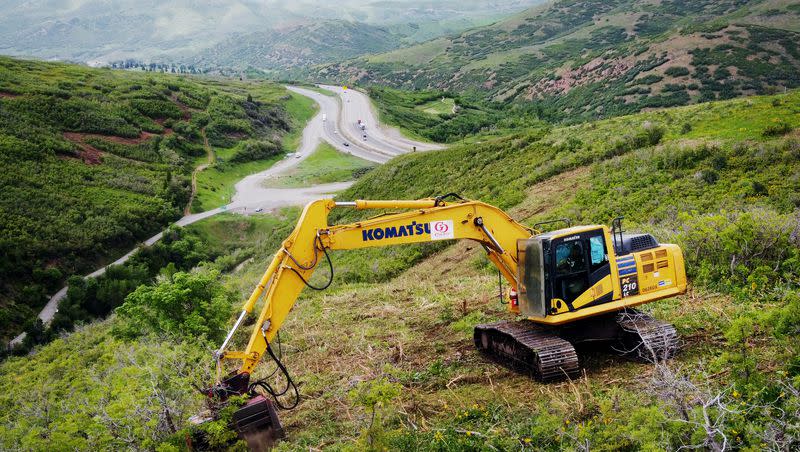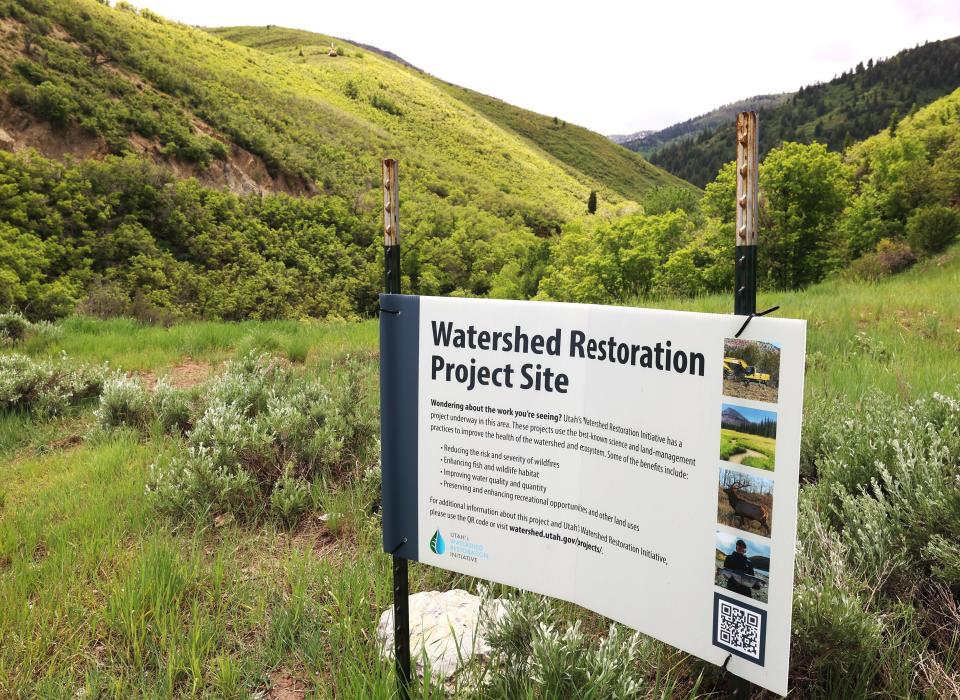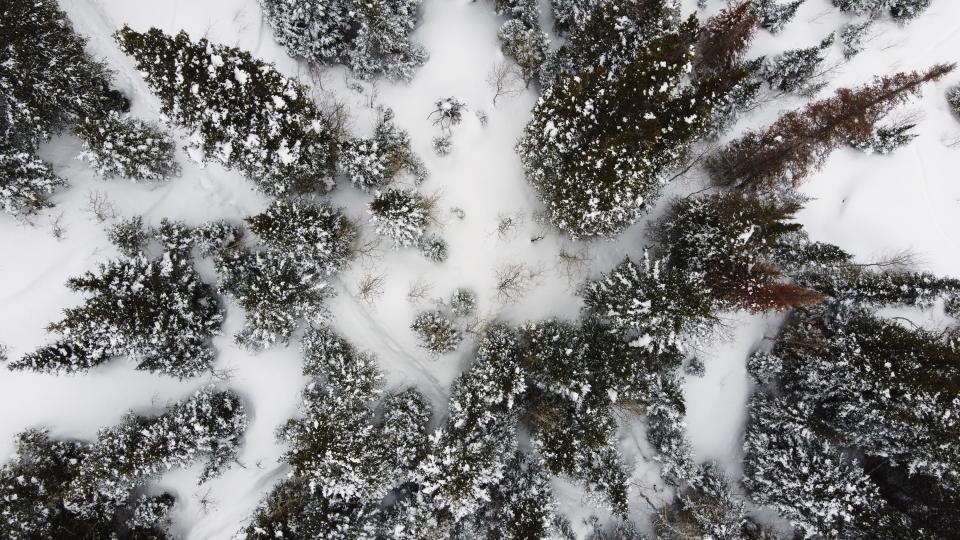Forest management critics call for tree thinning to prevent wildfires, improve watersheds

A controversial proposal that first surfaced in the 2023 Utah legislative session is once again being pushed by GOP Salt Lake County Council member Dea Theodore, who contends bush and tree thinning in the Great Salt Lake watershed will reduce the risk of wildfires, boost public safety and increase water yield.
Theodore’s most recent request implores Gov. Spencer Cox; Utah House Speaker Brad Wilson, R-Kaysville; Senate President Stuart Adams, R-Layton; and Great Salt Lake Commissioner Brian Steed to shepherd a number of strategies, including the establishment of a statewide program to eliminate non-native trees that consume excessive amounts of water and to particularly assess those liabilities in the Jordan River watershed. That water flows into the Great Salt Lake.
In addition, she’s requesting the installation of instrumentation equipment that measures results in areas that have been treated and to work with private landowners to advance aspen restoration. Her funding ask is for $100 million a year beginning in 2024 for five years for allocation to the Utah Watershed Restoration Initiative.
“My focus and goals are healthy watersheds and their relationship to public safety,” she said. “We achieve these goals through thoughtful and fact-based discussions, pushing the technology envelope and implementing best management practices.”
Scientists have slammed Theodore’s assertion that vegetation management — including that of conifers — will result in any quantifiable extra water.
In February, the Great Salt Lake Strike Team Report released by the Kem Gardner Institute of Policy at the University of Utah conceded that forests in Utah are overgrown and increase the potential for high intensity wildfires.
But it notes: “In the past decade or so a growing body of research has shown both increases and decreases in streamflow following canopy reduction,” stressing that the impact of tree thinning to help the world’s eighth largest terminal lake or its tributaries is unclear and would likely to be minimal or could potentially even decrease flows.
Utah Physicians for a Healthy Environment and the John Muir Project, too, recently warned of “massive malpractice” happening in Utah’s forests and said stepped up federal and state efforts to log or otherwise thin forests and landscapes is something Utah residents should demand be rejected, including the use of chainsaws, prescribed burns and pesticides.
But Theodore remains committed to her assertion that strategic thinning of trees, including non-natives and, yes, conifers, will provide ecological benefits.
Theodore raised the issue of tree thinning at a 2023 legislative caucus session as a way to accomplish a three-tiered mission: improve forest health, decrease wildfire risks and amplify water yield to flow to the Great Salt Lake. The lake dropped to its lowest level in modern recorded history last year, but has since risen five feet because of the state’s record snowpack.
Related
The proposal was heartily welcomed by some and heavily criticized by others.
In the caucus meeting, retired federal hydrologist Randy Julander, who worked 38 years in Utah’s forests and watersheds, said overgrown landscapes packed with conifer trees steal water from other vegetation vital for healthy ecosystems, adding that proper thinning improves watersheds and is a tool to help increase water availability.
While Julander did not say more active tree thinning will fill the Great Salt Lake, he made it clear that fewer straws in the pond means more water for streamflows if tree thinning is used as a strategic target.
“You have to treat the water producing areas,” he said. “You don’t have to treat the whole dang forest but (be) willing to treat the area that is proximal to the stream, the water contributing area of the watershed itself,” he told KSL.
Theodore was accused of promoting a myopic approach that sent the wrong message by dismissing other conservation efforts to manage water in the midst of Utah’s drought.
The buzz about tree thinning
Tree thinning is simultaneously endorsed, controversial and complicated, hailed by some experts who say it improves watershed health in the reduction of wildfires and the number of water-sucking vegetation that contribute to poor landscapes. Others contend the landscapes should be left alone.
Removal of standing trees or brush for landscape management takes many forms, including mechanical means like chainsaws, heavy chains, bull hogs (which mulch trees and bushes), or prescribed burns and chemical treatments.
The amount of trees or brush that get the ax is contingent on resource management plans by government agencies, funding, impact to the environment and projected results. Depending on topography and multiple conditions, some scientists say thinning can impact water availability in an area.
Related
The Utah Watershed Restoration Initiative, the Utah Geological Survey and the Utah Division of Water Quality are involved in an ongoing study of conifer removal projects of pinyon and juniper in the state and will assess if they are resulting in a higher groundwater table and increased spring or stream flows.
“We are measuring streams, springs and shallow groundwater as well as soil moisture,” said Tyler Thompson, the initiative’s executive director.
Of the roughly 3,800 acres planned for thinning, scientists and researchers are particularly focused on a 1,200-acre cut in the Mud Spring Two treatment area in Juab County.
Hugh Hurlow, senior scientist with the groundwater and wetlands program of the Utah Geological Survey, said he expects some preliminary analysis will begin later this year or into 2024.
The analysis, he said, has deliberately been delayed due to the record wet year in Utah and in the Great Basin region, which received an astounding 253% of normal precipitation that could skew results. The basin stretches from the Sierras on the west to the Wasatch Range in Utah on the east.
Related
Hurlow pointed to a study in central Oregon covering 12 years of treatment of pinyon and juniper pine that showed significant increases in spring flow and groundwater recharge.
Because of the similarities in topography and climate to central Oregon, Harlow said the Mud Spring Two treatment area may see hydrological benefit.
“I’m expecting something more like increased local spring flow, increased local soil moisture, that kind of thing and higher local groundwater tables, but far as delivery of extra water out of the watershed, probably not.”
Hurlow said he anticipates there will be some study areas that produce measurable results and others that do not.
He added that improved local water yield should not be promoted as a reason to do thinning projects, but rather to improve landscape health such as sagebrush steppe in the Great Basin where pinyon and juniper encroachment harms the imperiled greater sage grouse.
A study by Brigham Young University, Oregon State, the Forest Service and the U.S. Geological Survey’s New England Water Science Center found that soils remain wetter longer in the spring after tree thinning in a sagebrush ecosystem, including areas in Utah that include Tooele County.
“Managers remove trees to reduce fuel loads and increase cover and density of desirable understory species. Tree expansion decreased, while tree removal by prescribed fire or mechanical means increased the time of available water in springtime,” the study said. “We found that the time of soil water availability for understory plant growth was increased even 12–13 years after tree reduction.”
Conversely, tree thinning can result in soil erosion and have the opposite outcome — curtailing or jeopardizing the efficiency of runoff and degrading ecosystem health.

Watershed health, wildfires and thinning
Theodore, who represents the Wasatch Canyons on the Salt Lake County Council, said the mountains are a fire trap because they are overgrown and have only one way in and out.
“Ensuring safe havens from wildfires in the mountainous regions of the Wasatch is of utmost importance as much of the area is at high wildfire risk. Moreover, Little Cottonwood and Millcreek canyons lack secondary escape routes, while Big Cottonwood Canyon only has a seasonal, potentially insufficient route,” she said. “Given the limited or non-existent escape options, it is vital to create well-planned, thinned or cleared safety areas to save lives,” her plea to elected officials states.
The Utah Wildfire Risk Assessment deemed Salt Lake as the county most at risk in the state for wildfires, with nearly 60% of its land at “very, very high” risk, followed by Davis County with 47% of land in that same category. And that number is from 2018 and excludes the high mountain subdivisions that have sprung up in the five years since.
Like California, some home insurance companies are declining coverage in fire prone areas of the Wasatch Back. The companies are using a wildfire risk mapping system to “score” a home for its vulnerabilities.
Beyond wildfires, the drought in California led researchers to examine the Sierra basin to take another look at earlier estimates of water consumption by overstocked forests versus less-dense and healthier forests — at both lower elevation forest cover and at higher elevations.
That peer reviewed research, published in eScholarship, cited previous studies to offer: “There is substantial consensus that forest thinning above a certain threshold reduces evapotranspiration (ET) and increases runoff.”
Elsewhere, Denver has an agreement with the Forest Service to both pitch in $16.5 million over a five-year period to treat upstream forested areas to protect water supplies, as reported by the High Country News.
While critics, including some scientists, have debunked thinning forests as a way to get more water to the Great Salt Lake, efforts in New Mexico like the one involving The Nature Conservancy and the Denver project are designed to protect critical watersheds that supply drinking water — systems that have also been compromised in Utah’s towns of Huntington and Stockton.
Most recently, 128 acres were thinned on Salt Lake City lands and 194 acres on U.S. Forest Service lands within the Parleys Creek watershed, targeting oak brush and creating fire breaks to improve wildlife habitat and protect Parleys Creek. The creek supplies 20% of Salt Lake City’s drinking water and is one of five creeks that dump into the Jordan River and flow into the Great Salt Lake.
“This project is an important component of Salt Lake City’s overall watershed protection efforts,” said Laura Briefer, director of Salt Lake City Department of Public Utilities. “Salt Lake City’s drinking water quality is very important to our community. A catastrophic wildfire would pose a significant risk to the city’s drinking water quality and supply.”
Theodore said her proposal has the support of representatives of 22 of 29 counties in Utah, private landowners and several lawmakers, as well as Mike Styler, who headed up the Utah Department of Natural Resources, is a former legislator and helped develop the Watershed Restoration Initiative into a robust program.

Related

